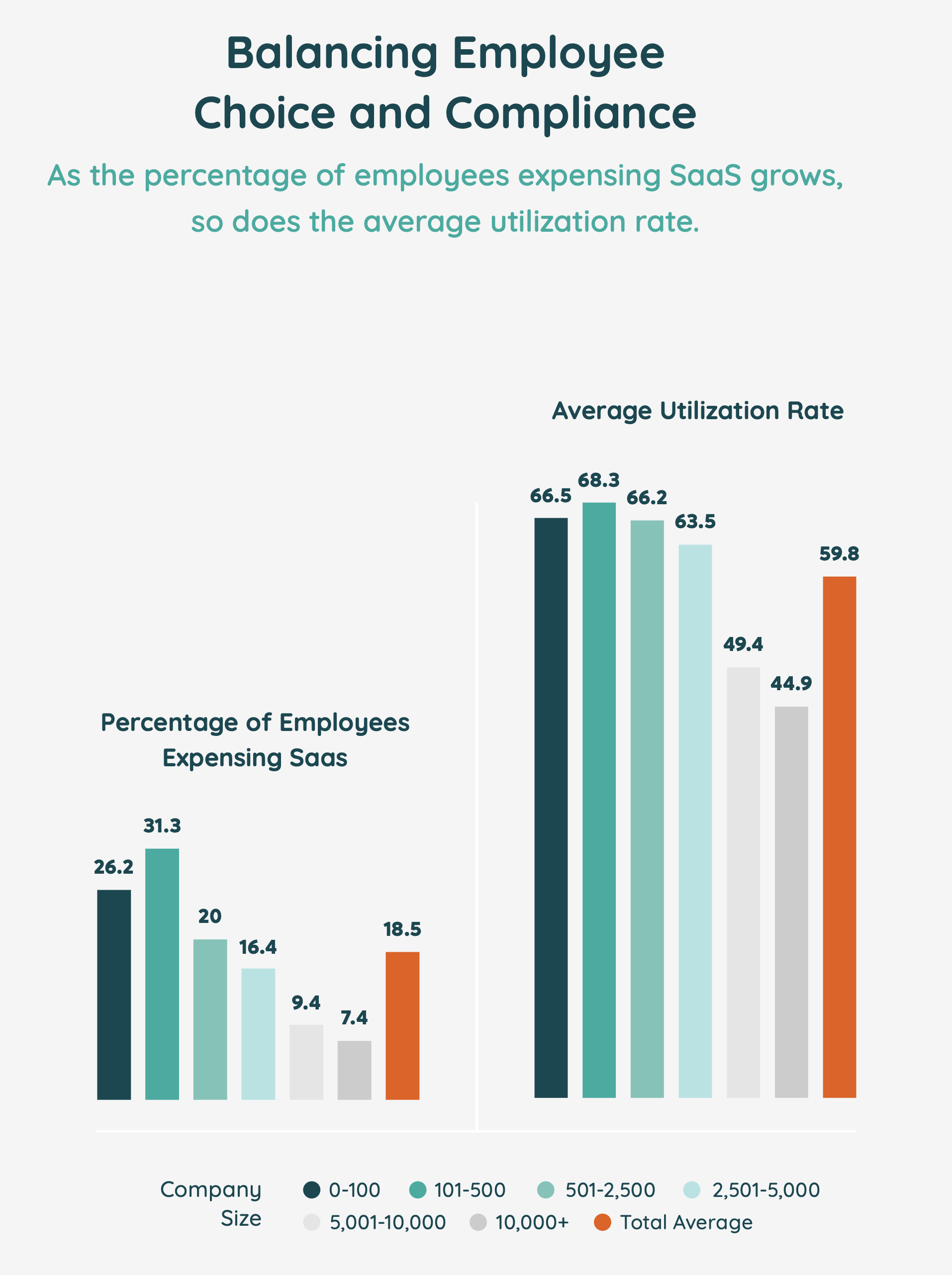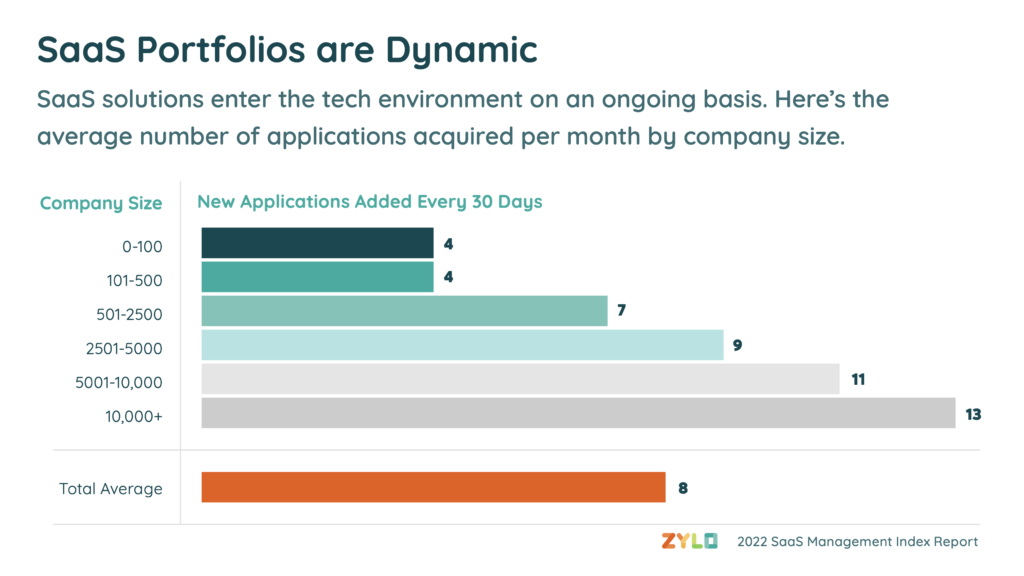
As an “armchair analyst” in martech, my favorite content comes from stack “aggregation” platform companies who publish the data of what their customers are actually doing. Unlike surveys that can be wildly biased and imprecise, aggregated usage data is empirical truth, straight up. Like the martech landscape, you can argue “why” and “where next,” but you can’t argue “what” the data is in the present.
This week’s aggregated data gift is the 2022 SaaS Management Index released by Zylo, a SaaS management platform. SaaS management platforms such as Zylo, Torii, Blissfully, Proactiv, BetterCloud, etc., operate in the governance layer of tech stacks. They aggregate subscription management for all your different SaaS products, from cost optimization and renewal management to onboarding and offboarding employees with their toolsets.
As with other aggregation platforms, they’re not pretending your stack is going to shrink any time soon. Instead, their goal is to make it easier and more efficient to leverage a large and diverse collection of apps. Tame the chaos, but enable specialization and continuous innovation.

Zylo is one of the leaders in the category, with more than $21 billion in SaaS spend and over 29 million licenses under management. Their scale lends significance to the statistics of aggregate data that they’ve shared in their index.
The headline stat, of course, is the average size of tech stacks, which continue to expand:
- Small to mid-size companies have an average of 217 apps
- Enterprise companies have an average of 330 apps
- Large enterprise companies have an average of — woof — 609 apps
Actually, is that even headline-worthy now? A couple of years ago, sharing a stat like that would elicit a fair amount of pushback, either “Bull-honkey!” or “Well, clearly that’s going to collapse!” (Admittedly, no one ever said bull-honkey, but hey, this is a family martech blog.) But now? I suspect most of you are involuntarily nodding in acknowledgement.
The sky is blue. The ocean is wet. Tech stacks have a lot of apps.
Another trend from Zylo’s index that might not surprise you either is that only 27% of SaaS spend is managed by IT — a 35% decrease year-over-year. Instead, business units manage 66% of their own SaaS spend, a 22% increase. (Zylo didn’t identify how the remaining 7% was managed. Perhaps by individuals or external service providers?)
I can’t imagine that anyone would call that 66% of business-unit-owned SaaS “shadow IT” anymore. But if they did, it’s the kind of shadow that a towering landmark casts in the bright light of day. Tourists pay money to visit it and take selfies.
But perhaps closer to the original definition of shadow IT, Zylo’s index reveals that a fair number of individual employees now buy their own SaaS tools and just expense them. About 1 in 5.

At small companies up to 100 employees and at mid-size ones up to 500 employees, the practice of expensing individual SaaS subscriptions is most likely, at 26.2% and 31.3% respectively. However, at larger enterprises, the rate drops to under 10%. (It correlates inversely with the number of compliance officers on staff, I hypothesize.)
But a more interesting correlation Zylo found was this: the more employees in a company expense their own SaaS apps, the greater the utilization rate of SaaS apps in the company overall. The patterns in the left and right graphs above are nearly identical.
(Quick aside: I’ve long argued against utilization rates of martech as a meaningful metric. But that’s when talking about the utilization of features and capabilities within a particular SaaS product. In Zylo’s index, utilization rate seems to be a more binary measurement: is the app being used at all, yes or no, by each person who has a license to use it.)
Does increased choice — pick your own apps and expense ’em — increase utilization?
The data doesn’t prove causation. In fact, since both are correlated with the size of the business, small to enterprise, there are plenty of other explanations. But still, it’s a viable thesis to me.
People use the tools that they like and they’ve chosen to help them do their best work. Any other tool chosen by central command that’s unfamiliar or liked less is less likely to get used. That’s not to say that most of the stack shouldn’t be standardized. It should be. Bring-Your-Own-CRM is probably an even worse policy than Bring-Your-Badger-to-Work Day.
But letting individuals and teams augment your core stack platforms with their preferred complementary specialist apps? With reasonable guardrails, it makes sense. Growing integration and interoperability make it possible.
One of the martech trends for 2022 that I wrote about earlier this month was the rise of the “in-house creator.” Independent creators leverage a whole bevy of apps and no-code tools — along with their own creativity and drive — to rapidly build amazing things on shoestring budgets, often as late-night side hustles. They are paragons of productivity.
So why not invite people to work like that inside a company?
The creativity and productivity of the creator. Magnified by the scale and reach of the corporation. It’s not without cultural and compliance challenges. But, wow, what potential energy that combination has. And in the endless war for talent, inviting creator types to bring both their imagination and their preferred tool-belt to a steady, high-paying gig with enormous amplification isn’t a crazy idea.
One last stat to leave you with from that Zylo report, the average number of new apps a company adds to their SaaS stack every 30 days:

In small companies up to 500 employees, 4 apps added per month is equivalent to one new app every week. In large enterprises, with 11-13 new apps per month, it’s like a new app being added every other day — somewhere, by someone, for something.
In short: Your stack isn’t static. It’s a living creature.
I know, for some that might seem horrifying, like The Thing. For me, it’s awe and wonder, like a coral reef.
Download the full Zylo report here.


